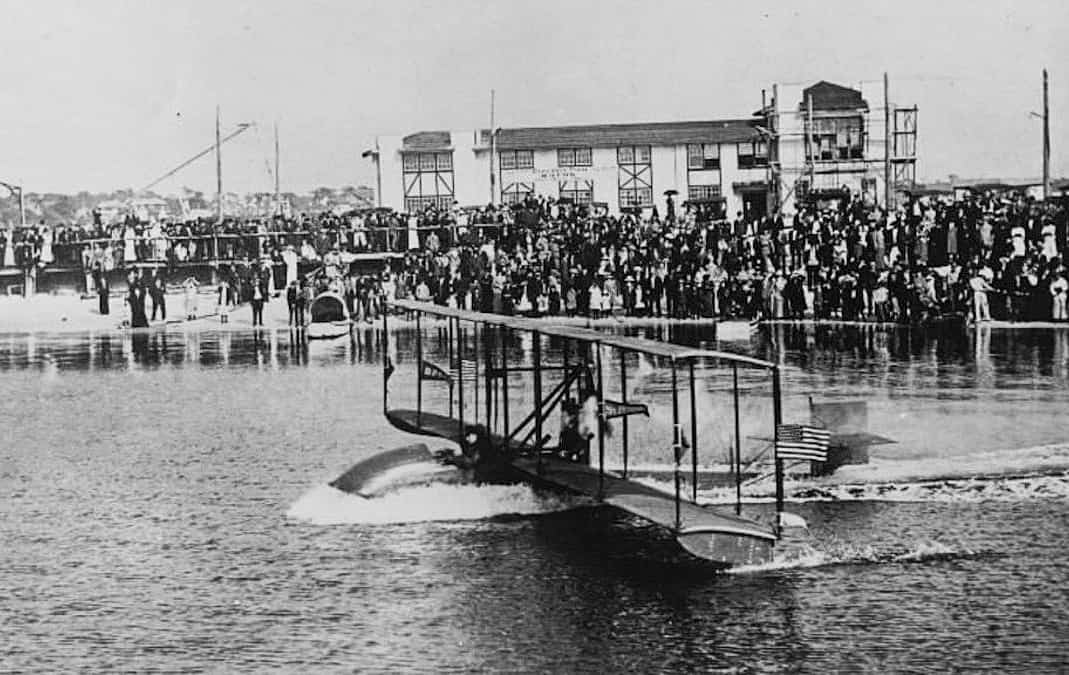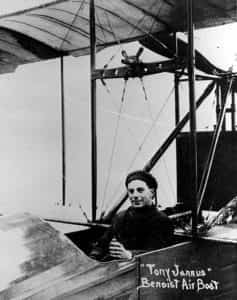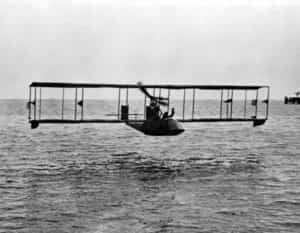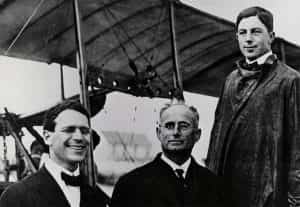Create
VINTAGE ST. PETE: Tony Jannus and his flight into history

Man has conquered the elements, the last element to be brought under subjugation being the air. Yesterday demonstrated the fact that air lines will in the very near future be used for transit purposes, and the line from this city across the bay is the pioneer of them all.
St. Petersburg Times/Jan. 2, 1914
 Aviator Tony Jannus made history on Jan. 1, 1914 by carrying the first ticket-buying airplane passenger on a scheduled run. The 23-mile journey from St. Petersburg to Tampa, in a Benoist XIV “flying boat,” took 21 minutes (Jannus, the famous daredevil and flying ace, would later trim his time to 19 minutes).
Aviator Tony Jannus made history on Jan. 1, 1914 by carrying the first ticket-buying airplane passenger on a scheduled run. The 23-mile journey from St. Petersburg to Tampa, in a Benoist XIV “flying boat,” took 21 minutes (Jannus, the famous daredevil and flying ace, would later trim his time to 19 minutes).
This was St. Petersburg’s first “first,” and the beginning of scheduled passenger airline service, anywhere. The names of pilot Jannus, aircraft designer and builder Thomas Benoist (“ben-wah”) and Abram C. Pheil, the former St. Pete mayor who plunked down $400 to sit in the passenger seat, are justifiably well-known.
There is one name, however, that rarely gets mentioned in the same breath: The historic biplane, made of spruce, fabric and wire bracing with a wobbly wingspan of 40 feet, was known, improbably, as The Lark of Duluth.
The St. Louis-based Benoist sold this particular “flying boat” to Minnesota businessman Julius Howland Barnes in 1913, who hired the D.C.-born Jannus and his brother Roger, also a pilot, to fly thrill-seekers over Lake Superior during the warm summer months.
Powered by a Roberts 75 horsepower, 6-cylinder, water-cooled engine, the aircraft flew between five and 50 feet above the water (usually at the lower altitudes), at a maximum speed of 64 miles per hour.
As the cooler seasons approached, the brothers convinced Barnes to loan The Lark of Duluth to them for a daring new project, 1,650 miles away in Florida.
The ambitious venture was to be called the St. Petersburg-Tampa Airboat Line.
“It changed not just American culture, but world culture,” says local historian Will Michaels, who spearheaded centennial celebrations in 2014. “The world shrunk as a result of this.”

Jannus waves to the crowd as The Lark of Duluth prepares to land in the Hillsborough River.
Michaels, the author of The Making of St. Petersburg, is one of the architects of the First Airline Monument Project, which will soon erect a life-sized sculpture of The Lark of Duluth at the St. Pete Pier. The massive steel structure, which includes the seated figures of Jannus and Pheil, mid-flight, was designed and built by local sculptor Mark Aeling. A dedication ceremony is planned for early February.
The pier site is significant. For it was here – on the south side of the wooden St. Petersburg Municipal Recreation Pier – that Benoist and his business partner, Jacksonville electrical engineer Percival Fansler, constructed the hangar for The Lark of Duluth and another biplane, Florida. Jannus’ historic first flight began there, as the ungainly-looking aircraft – literally more of a boat with wings – slid down a greased ramp into Tampa Bay on Jan. 1, 1914.
Fansler, explains Michaels, was key: He cooked up the idea of scheduling flights and carrying passengers.
There were no cross-bay bridges yet; a trip from one city to the other took up to 12 hours by train, a little longer via automobile (on unpaved and uncertain roads), and two potentially bumpy hours by passenger boat. According to Michaels, the service was pitched as both a novelty for tourists and an ultra-convenient taxi for businessmen going back and forth between St. Petersburg and Tampa.
The airplane, in those days, “was viewed more as a toy – a big toy – than anything serious,” Michaels says. “And Fansler said ‘Well, let’s take this toy, this publicity stunt stuff, if you will, and let’s turn it into a serious business.’ That was his approach to Benoist and Jannus.
“He looked around for cities that were close together, so Tampa and St. Petersburg fit the bill. The weather was reasonably good here, especially in January. Plus, they were dealing with airboats, so they needed water.”
With the City of St. Petersburg subsidizing the business, and the Board of Trade (a precursor to the Chamber of Commerce) fully invested, the St. Petersburg-Tampa Airboat Line was publicized throughout the country. “If it didn’t come off,” says Michaels, “it was going to be a huge embarrassment.”
The marketing push seemed to work. In 1914, the population of St. Petersburg was around 7,000 – when launch day arrived, 3,000 people thronged the waterfront to watch the daring young flyboy and his passenger depart. Pheil, in fact, got his ticket via a winning bid in a charity auction shortly before the craft slid down the ramp at 10 a.m.
In an odd bit of airline foreshadowing, The Lark of Duluth – disassembled at the Benoist facility in St. Louis – literally got lost in shipment. The Atlantic Freight Lines train finally delivered the “flying machine” midafternoon on Dec. 30, less than 48 hours before the first flight.
Tony Jannus last night stated that the presence of a large crowd would not bother him in the least, and that he expects the usual coterie of small boys, and large ones, too, to be there to “superintend” the work of assembling the machine.
St. Petersburg Times/Dec. 31, 1913
The flight itself was uneventful, although Jannus did have to set the airboat down once to re-start the engine. Pheil got wet, and oily. Approximately 3,500 people were waiting alongside the designated landing area on the Hillsborough River, by the Lafayette Street Bridge – near the present site of the Tampa Convention Center.
Conspicuously missing from the assembled was Donald McKay, the mayor of Tampa. Pheil, nonplussed at being stood up, left to pick up machine parts for his dredging business. When he returned to the river site, the mayor was there, and the requisite photos were quickly taken.
Jannus and Pheil were airborne at 11 and headed back across the bay towards St. Petersburg.
“One thing we don’t talk about much here is that Fansler actually went to the Tampa Board of Trade first, and pitched it to them,” Michaels laughs. “And they wouldn’t have anything to do with it.”

From left Percival Fansler, Abram C. Pheil and Tony Jannus
Scheduled flights – two per day, six days a week – began that day. Tickets were $5 one-way, and $10 for a round trip. The airline carried freight, too. Excursion trips, flights over the beaches or the nether regions of Tampa Bay, could be arranged for a fee.
A Jan. 14 story on the front page of the St. Petersburg Times announced that one Harry Railsback had hired Jannus to take him duck hunting in the bay; Railsback shot three “fine birds” while the Benoist was in the air. Jannus landed the plane so the downed ducks could be retrieved.
The handsome, dark-haired Jannus was a 25-year-old bachelor, and the biggest celebrity in St. Petersburg. A quote attributed to Eleanor C. Reed, his local landlady: “He was so thoughtful of others, and had such a winning personality, that he was constantly being sought after by the girls. He did not know sometimes which way to turn.”
The wind went out of the St. Petersburg-Tampa Airboat Line, as was expected, when the area’s winter visitors went home to New England and the Midwest in late spring.
 The contract ended on May 5. The final tally: Four months of service, 7,000 air miles, a total of 1,205 passengers. Financially, the company barely broke even.
The contract ended on May 5. The final tally: Four months of service, 7,000 air miles, a total of 1,205 passengers. Financially, the company barely broke even.
While The Lark of Duluth was back in Minnesota flying exhibitions and excursions for the summer, plans were made – between Fansler, Benoist and Jannus – to re-convene cross-bay airline service back in January, 1915.
“We have not made much money,” Benoist said, “but I believe we have proved that the airplane can be successfully used as a regular means of transportation and commercial carrier.”
During that year, however, rail service between St. Petersburg and Tampa was vastly improved, making the journey much shorter. World War I began in Europe, a conflict that would soon engulf the United States and turn the public’s attention away from novelty flying machines.
And when the city subsidy ran out, the decision was made to end the airboat experiment. It would be up to others to mold passenger aviation into a viable commercial enterprise.
In 1915, The Lark of Duluth was damaged beyond repair during a hard landing in San Diego. Tony Jannus died the following year when his plane crashed in Sevastopol, Russia, while training pilots for the war. Roger Jannus died in 1918, under similar circumstances.
The bottom line? “The airline did not come back to St. Petersburg,” Will Michaels says, “but that was the spark that initiated the idea or organizing this ‘huge toy’ and all these exhibitions into a regular business.”
Which is why Mark Aeling’s life-sized steel sculpture of the plane, the pilot and the passenger, was installed in December 2020 at the new St. Pete Pier, and officially dedicated in February.
One hundred and six years after he flew into history, Tony Jannus still holds the record for the shortest time between the big cities on the bay.

Photo by Bill DeYoung.







Hugh J. Hazeltine
March 2, 2025at4:53 pm
Fansler was 33 at the time and a graduate of Purdue University. He and his pregnant wife moved to St. Pete from Jacksonville. He had also pitched the idea there and did not get any support.
Cole Holt
October 26, 2020at9:28 am
I thoroughly enjoyed reading this before starting my work day, thank you!